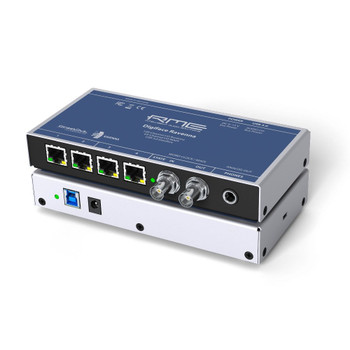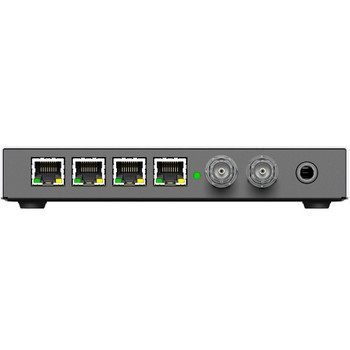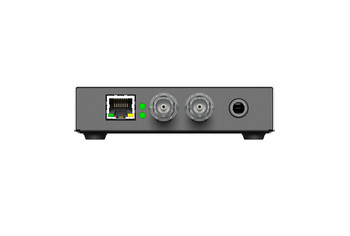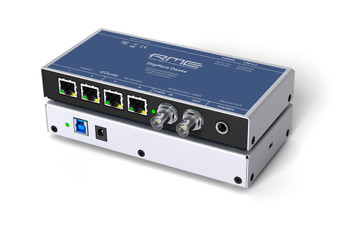Description
RME Digiface AES
30-Channel, 192 kHz USB Bus-Powered Interface With SRC
- USB Bus-Powered Audio Interface for PC, Mac and iPadOS
- Integrated SRC (Sample Rate Converter)
- Full stand-alone operation
- SteadyClock FS
- Optional: RME ARC USB (Advanced Remote Control)
- 5 Year Warranty (UK Only)
Connections:
- 14 Input / 16 Output channels
- 2 x Mic/ Line Preamps, digitally controlled
- 2 x Line Outputs (XLR)
- 1 x Headphone Output / Unbalanced line out
- 1 x AES/EBU I/O
- 1 x SPDIF I/O (Coaxial)
- 1 x ADAT I/O (or SPDIF Optical)
- Word clock I/O (switchable)
- 1 x MIDI I/O (via MIDI Breakout Cable)
- USB 2.0 (USB 3 and USB-C compatible)
The RME Digiface AES is a professional 14 input and 16 output channel USB 2.0 interface with 2 x Mic/Line analogue input channels and 4 x analogue output channels (2 XLR, one TRS phones) to complement its digital I/O section.
With an excellent set of digital connectivity, SteadyClock FS, full stand-alone operation and built-in parametric EQ, the Digiface AES shines as the perfect all-in-one solution for recording and playback of digital and analogue sources, as well as flexible playback/monitoring via TotalMix FX.
Bus-power compatibility meets flexible Analogue I/O Performance
The Digiface AES can be bus-powered over USB, doing away with the need for an external power supply. At the same time, the Digiface AES also ships with an included external DC-power supply for use in stand-alone operation, or as a secondary fail-safe against any potential computer failures.
For the main inputs RME uses the proven mic/line preamps in XLR combo configuration of the Babyface Pro FS. Two digitally controlled preamps provide individually switchable 48V phantom power. These circuits feature a gain range of 75 dB, adjustable in steps of 1 dB, including a relay-driven PAD, resulting in exceptional EIN (Equivalent Input Noise) performance as well as line overload protection, and enough gain for even the lowest level microphones.
On the back of the Digiface AES there are 2 balanced analogue outputs via XLR male to drive power amps, active monitor speakers, or recordings. The headphone output allows additional and independent high quality monitoring, providing sufficient output power and volume on high and low impedance headphones.
Versatile Digital Input and Output Connectivity
The comprehensive set of digital I/Os, centered around an AES/EBU input and output via XLR, also includes SPDIF coax, SPDIF optical or 8-channel ADAT.
All I/Os can be used simultaneously, turning the unit into a swiss-army-knife interface that receives and sends all common digital audio formats.
MIDI I/O via an included breakout cable completes the package.
Integrated SRC (Sample Rate Converter)
An integrated SRC (Sample Rate Converter) can be switched to one of the three inputs to solve clocking issues and to adapt to other sample rates.
This allows, for example, the device to be AES clock-synchronized from the main source and to listen to SPDIF independently at the same time.
Full Stand-alone Functionality
Convenient, direct access and control of all features is available directly from the front panel. Four select keys; an encoder; a high-resolution display with clear color output; and a well thought-out menu structure allow for quick changes and configuration of the device.
Six different device setups can be stored into internal memory, transforming the Digiface AES into totally different devices at the simple click of a button - especially useful in stand-alone mode. Furthermore TotalMix FX can also be controlled externally via MIDI.
Powerful Applications for Mixing, Monitoring and Measurement included
The Digiface AES also includes the powerful digital real-time mixer TotalMix FX. It allows fully independent routing and mixing of input and playback channels to all physical outputs. Independent stereo submixes plus a comprehensive Control Room section offer unrivalled monitoring capabilities and unsurpassed routing flexibility.
TotalMix Remote enhances the power of RME interfaces by enabling remote control via iOS, PC or Mac. With a straightforward set up process — simply enter the IP address of the computer you would like to control with TotalMix Remote and get going — users can quickly adjust any aspect of TotalMix FX on a host system while walking around the studio with their tablet, or from a control room located elsewhere in the facility.
Included Accessories
- USB 2.0 Cable, 1.8 m (6 ft)
- MIDI Breakout Cable
- External power supply with locking connector
- Power cable
TotalMix FX & DIGICheck
The Digiface AES comes with the TotalMix FX DSP mixer offering comprehensive routing and monitoring options, as well as the DIGICheck Analyzer allowing to measure and analyze the digital data feed in both directions with maximum precision.
RME's DSP-based TotalMix FX mixer allows for fully independent routing and mixing of all 14 input and playback channels to all 16 physical outputs. Independent stereo submixes, plus a comprehensive Control Room section, offer unrivalled monitoring capabilities and unsurpassed routing flexibility.
Every input and output channel comes with a luxury feature set, comparable to that of a full-scale digital console. The effects per channel include 3-band parametric EQ (and adjustable Low Cut), a Dynamics section (Compressor, Expander), MS Processing and phase reversal. The Reverb and Echo effects unit is available for all channels by a stereo send and return bus, all of which is offered even at 192 kHz operation.
Latency-Free Monitoring
The complete effects section not only adds flexibility to the recording chain , but even does away with the need for an external mixer or additional latency-inducing software. Latency-free monitor mixes can be easily created - complete with EQ and Reverb - e.g. for the main studio monitors and the headphone of the vocalist(s) in the recording room.
DIGICheck
RME’s DIGICheck Analyzer is a free suite of professional audio analysis tools, providing users with additional measurements digital data feed in both directions with maximum precision.
The set of tools includes comprehensive multi-channel level metering (peak and RMS); a 30-Band spectrum/frequency analyser, plus correlation meter and vectorscope; a loudness metering tool for checking against the IT 1770 / EBU R128 standards commonly found in broadcast; and a Surround Audio Scope for surround sound level metering with extended correlation analysis, ITU weighting and ITU summing.
Network Control via TotalMix Remote
TotalMix Remote is a network remote control app for all RME audio interfaces and sound cards. Available as a free download via the RME website, TotalMix Remote allows for full control of the hardware mixer and effects section of the Digiface AES via a network-connected PC, Mac or Apple iPad, including wirelessly over Wi-Fi!
TotalMix Remote mirrors the current state of the host system on the iPad and Windows/Mac computers - the entire mixing state, the complete routing, all FX settings, up to the level meters, and everything in real-time.
TotalMix Remote supports up to three hosts with multiple interfaces each, allowing Apple's popular iPad and Windows/Mac computers to adjust all the mixer and FX settings from a distance, via Ethernet and Wi-Fi.
SteadyClock FS - FemtoSecond Clocking Technology
The RME Fireface UCX II also features RME's latest digital clocking and jitter rejection technology, 'SteadyClock FS'. Originally developed for RME's award-winning ADI-2 Pro FS range of high-end AD/DA converters, SteadyClock FS reduces the intrinsic jitter (when converting to and from analogue over all digital formats) to a new all-time low.
All clock modes provide excellent performance and astonishingly high-quality analogue conversion, allowing you to hear your mix exactly as it is. What's more, RME's digital format conversion occurs without any loss to the signal, and SteadyClock FS ensures your sonic image will never experience any kind of degradation. This helps to optimize recordings and mixes, ensuring the soundstage is replicated to the fullest depth and clarity.
Optional: RME ARC USB (Advanced Remote Control)
The RME Digiface AES can also integrate with RME's optional ARC USB remote control (sold separately).
When connected to a computer's USB port, the ARC USB provides users with quick access to all of the most used functions of TotalMix FX, with 15 user-definable buttons, a large encoder wheel, and a TS jack for connecting a foot switch.
The RME ARC USB is a USB 1.1 MIDI remote control - thanks to operating as a UAC 1 class device, it is natively compatible to Windows and Mac OS X. As soon as it is present in the operating system, TotalMix FX will automatically detect the ARC USB, and communicate with it via simple MIDI remote commands to control the UCX II.
RME USB - Transport audio with lowest latency and industry leading stability
Use your RME audio interface on Mac and PC with reliable, stable, and regularly updated drivers. As RME Audio develops its own interface core, the Digiface AES isn't dependent on 3rd parties for upgrades, modifications or bug fixes, so customers can use latest operating systems without interruption or delay.
Specifications
General
- Power supply: USB bus power or external power supply
- Typical power consumption: 3 Watt
- Current at 12 V external power: 250 mA (3 Watt)
- Dimensions (BxHxT): 215 x 44 x 130 mm (8.46" x 1.73" x 5.1")
- Weight: 880 g (1.94 lbs)
- Temperature range: +5° up to +50° Celsius (41° F up to 122°F)
- Relative humidity: < 75%, non condensing
Analogue
- Microphone/Line In 1-2, XLR
- Input: XLR, electronically balanced
- Input impedance balanced @ 1 kHz: 2 kOhm, PAD 5,3 kOhm
- Input impedance unbalanced @ 1 kHz: 1 kOhm, PAD 2,6 kOhm
- Maximum input level, Gain 0 dB: +8 dBu
- Maximum input level, Gain 65 dB: -57 dBu
- Gain range: 65 dB
- EIN: -129 dBu A-weighted, 60 dB gain,150 Ohm, 20 Hz – 20 kHz
- Signal to Noise ratio (SNR): 113 dB RMS unweighted, 115 dBA
- Frequency response @ 44.1 kHz, -0,1 dB: 16 Hz – 20,4 kHz
- Frequency response @ 96 kHz, -0,5 dB: 7 Hz – 45,8 kHz
- Frequency response @ 192 kHz, -1 dB: 5 Hz – 88 kHz
- Frequency response PAD @ 44.1 kHz, -0,1 dB: 5 Hz – 20,4 kHz
- Frequency response PAD @ 96 kHz, -0,5 dB: 2,5 Hz – 45,8 kHz
- Frequency response PAD @ 192 kHz, -1 dB: 2 Hz – 88 kHz
- THD: < -110 dB, < 0,0003 %
- THD+N: < -106 dB, < 0,0005 %
- Channel separation: > 110 dB
- TRS In 1-2
- As XLR, but:
- Input: 6.3 mm TRS jack, electronically balanced
- Input impedance @ 1 kHz: 12 kOhm balanced, 6 kOhm unbalanced
- Maximum input level, Gain 0 dB: +24 dBu
- Maximum input level, Gain 65 dB: -41 dBu
- Frequency response @ 44.1 kHz, -0,1 dB: 2 Hz – 20,3 kHz
- Frequency response @ 96 kHz, -0,5 dB: 1,5 Hz – 44,3 kHz
- Frequency response @ 192 kHz, -1 dB: 1 Hz – 70 kHz
- DA, Line Out 1-2
- Output: XLR, electronically balanced
- Output level switchable +19 dBu, +13 dBu, +4 dBu
- Dynamic range (DR) @ +19 dBu: 120 dB (AES17), 123 dBA
- Dynamic range (DR) @ +13 dBu: 114 dB (AES17), 116,5 dBA
- Dynamic range (DR) @ +4 dBu: 114 dB (AES17), 116,5 dBA
- Frequency response @ 44.1 kHz, -0,5 dB: 0 Hz – 20,7 kHz
- Frequency response @ 96 kHz, -0,5 dB: 0 Hz – 45 kHz
- Frequency response @ 192 kHz, -1 dB: 0 Hz – 90,8 kHz
- THD: < -110 dB, < 0,0003 %
- THD+N: -110 dB, 0,0003 %
- Channel separation: > 110 dB
- Output impedance: 300 Ohm
- DA - Stereo Monitor Output Phones (7-8)
- as DA, but:
- Output: 6.3 mm TRS jack,unbalanced
- Output level at 0 dBFS, High: +13 dBu
- Output level at 0 dBFS, Low: +7 dBu
- Signal to Noise ratio (SNR) @ High: 120 dB (AES17), 122 dBA
- Signal to Noise ratio (SNR) @ Low: 114 dB (AES17), 116,5 dBA
- Output impedance: 5 Ohm
- Max power per channel, 32 Ohm load, 0,1% THD: 80 mW
- THD+N @ 32 Ohm load: -105 dB, 0,0005 %
MIDI
- 1 x MIDI I/O via breakout cable with 2 x 5-pin DIN jacks
- Galvanically isolated by optocoupled input
- Hi-speed mode: Jitter and response time typically below 1 ms
- Separate 128 byte FIFOs for input and output
Digital
- Clocks: Internal, AES, SPDIF, ADAT
- Jitter suppression of external clocks: > 50 dB (2.4 kHz)
- Effective clock jitter influence on AD and DA conversion: near zero
- Digital Bitclock PLL for trouble-free varispeed ADAT operation
- Supported sample rates: 28 kHz up to 200 kHz
Digital Inputs
- AES/EBU
- 1 x XLR, transformer-balanced, galvanically isolated, according to AES3-1992
- High-sensitivity input stage (< 0.3 Vpp)
- SPDIF compatible (IEC 60958)
- Accepts Consumer and Professional format
- Lock range: 27 kHz – 200 kHz
- Jitter suppression: > 30 dB (2.4 kHz)
- SPDIF coaxial
- 1 x RCA,according to IEC 60958
- High-sensitivity input stage (< 0.3 Vpp)
- Accepts Consumer and Professional format
- Lock range: 27 kHz – 200 kHz
- Jitter suppression: > 30 dB (2.4 kHz)
- ADAT Optical
- 2 x TOSLINK, Format according to Alesis specification
- Standard: 8 channels 24 bit, up to 48 kHz
- Double Speed (S/MUX): 4 channels 24 bit 96 kHz
- Quad Speed (S/MUX4) : 2 channels 24 bit 192 kHz
- Bitclock PLL ensures perfect synchronisation even in varispeed operation
- Lock Range: 31.5 kHz – 50 kHz
- Jitter suppression: > 50 dB (2.4 kHz)
- SRC
- The inputs AES, SPDIF coaxial or SPDIF optical switchable
- 2 channels, 32 up to 192 kHz
- Max. conversion ratio. 1:7 and 7:1
- THD+N: -139 dB
- Dynamic range (DR): 139 dB (AES17), 142 dBA
- Latency: 109 Samples, 2,47 ms @ 44,1 kHz, 1,14 ms @ 96 kHz, 0,57 ms @ 192 kHz
Digital Outputs
- AES/EBU
- XLR, transformer-balanced, galvanically isolated, according to AES3-1992
- Output impedance 5 Vss
- Format Professional according to AES3-1992 Amendment 4
- Single Wire Mode, Supported sample rates: 28 kHz up to 200 kHz
- SPDIF coaxial
- 1 x Cinch, according to IEC 60958
- Output impedance 0,7 Vss
- Format Consumer (SPDIF) according to IEC 60958
- Single Wire Mode, Supported sample rates: 28 kHz up to 200 kHz
- ADAT
- 1 x TOSLINK
- Standard: 8 channels 24 bit, up to 48 kHz
- Double Speed (S/MUX): 4 channels 24 bit 96 kHz
- Quad Speed (S/MUX4) : 2 channels 24 bit 192 kHz












